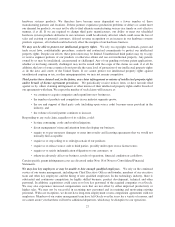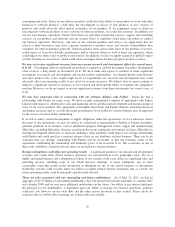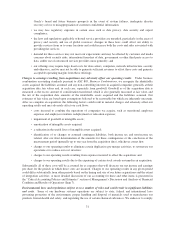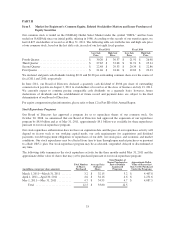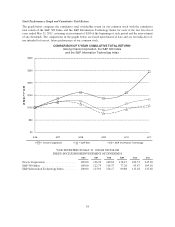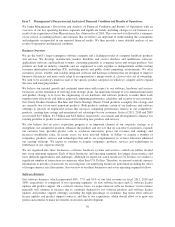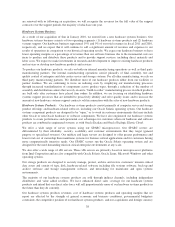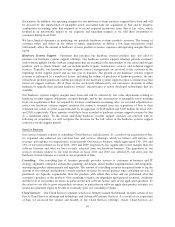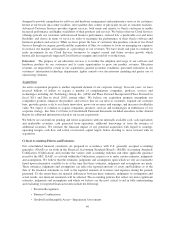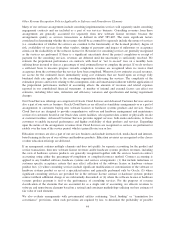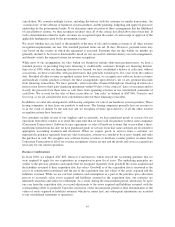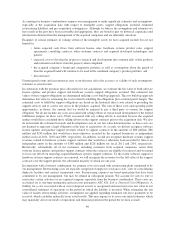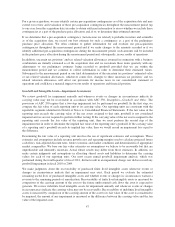Oracle 2011 Annual Report Download - page 39
Download and view the complete annual report
Please find page 39 of the 2011 Oracle annual report below. You can navigate through the pages in the report by either clicking on the pages listed below, or by using the keyword search tool below to find specific information within the annual report.New Software Licenses: We license our database and middleware as well as our applications software to
businesses of many sizes, government agencies, educational institutions and resellers. The growth in new
software license revenues that we report is affected by the strength of general economic and business conditions,
governmental budgetary constraints, the competitive position of our software products, our acquisitions and
foreign currency fluctuations. The substantial majority of our new software license business is also characterized
by long sales cycles. The timing of a few large software license transactions can substantially affect our quarterly
new software license revenues. Since our new software license revenues in a particular quarter can be difficult to
predict as a result of the timing of a few large software license transactions, we believe that analysis of new
software license revenues on a trailing 4-quarter period (as provided in our Quarterly Reports on Form 10-Q)
provides additional visibility into the underlying performance of our new software license business. New
software license revenues represented 26%, 28% and 31% of our total revenues in fiscal 2011, 2010 and 2009,
respectively. The proportion of our new software license revenues relative to our total revenues in fiscal 2011
and 2010 was affected by our entry into the hardware systems business as a result of our acquisition of Sun. Our
new software license segment’s margins have historically trended upward over the course of the four quarters
within a particular fiscal year due to the historical upward trend of our new software license revenues over those
quarterly periods and because the majority of our costs for this segment are predominantly fixed in the short-
term. However, our new software license segment’s margins have been and will continue to be affected by the
amortization of intangible assets associated with companies that we have acquired.
Software License Updates and Product Support: Customers that purchase software license updates and
product support are granted rights to unspecified product upgrades and maintenance releases issued during the
support period, as well as technical support assistance. Substantially all of our customers renew their software
license updates and product support contracts annually. The growth of software license updates and product
support revenues is primarily influenced by three factors: (1) the percentage of our support contract customer
base that renews its support contracts, (2) the amount of new support contracts sold in connection with the sale of
new software licenses, and (3) the amount of support contracts assumed from companies we have acquired.
Software license updates and product support revenues, which represented 42%, 49% and 50% of our total
revenues in fiscal 2011, 2010 and 2009, respectively, is our highest margin business unit. The proportion of our
software license updates and product support revenues relative to our total revenues in fiscal 2011 and 2010 was
affected by our entry into the hardware systems business as a result of our acquisition of Sun. Support margins
during fiscal 2011 were 86% and accounted for 70% of our total margins. Our software license update and
product support margins have been affected by fair value adjustments relating to support obligations assumed in
business combinations (described further below) and by amortization of intangible assets. However, over the
longer term, we believe that software license updates and product support revenues and margins will grow for the
following reasons:
• substantially all of our customers, including customers from acquired companies, renew their support
contracts when eligible for renewal;
• substantially all of our customers purchase software license updates and product support contracts
when they buy new software licenses, resulting in a further increase in our support contract base. Even
if new software license revenues growth was flat, software license updates and product support
revenues would continue to grow in comparison to the corresponding prior year periods assuming
renewal and cancellation rates and foreign currency rates remained relatively constant since
substantially all new software license transactions result in the sale of software license updates and
product support contracts, which add to our support contract base; and
• our acquisitions have increased our support contract base, as well as the portfolio of products available
to be licensed and supported.
We recorded adjustments to reduce support obligations assumed in business combinations to their estimated fair
values at the acquisition dates. As a result, as required by business combination accounting rules, we did not
recognize software license updates and product support revenues related to support contracts that would have
been otherwise recorded by the acquired businesses as independent entities in the amount of $80 million, $86
million and $243 million in fiscal 2011, 2010 and 2009, respectively. To the extent underlying support contracts
37


